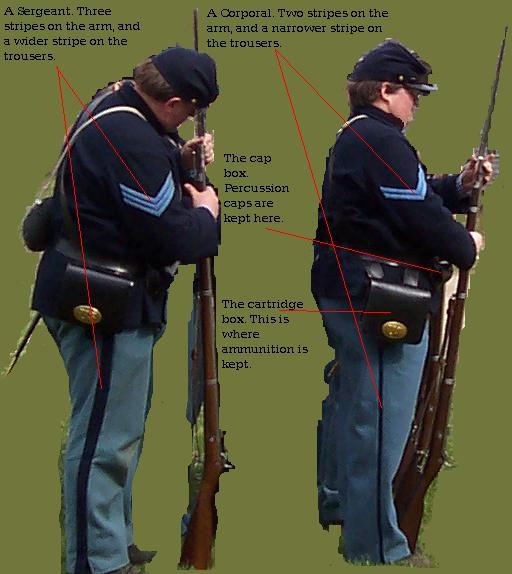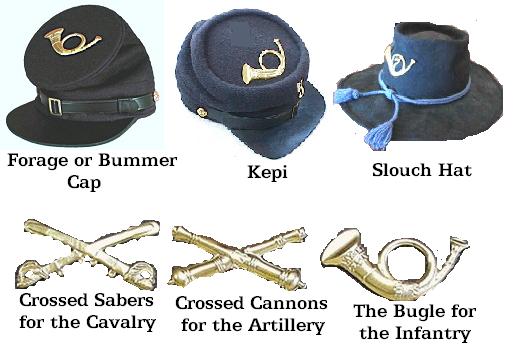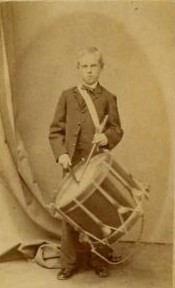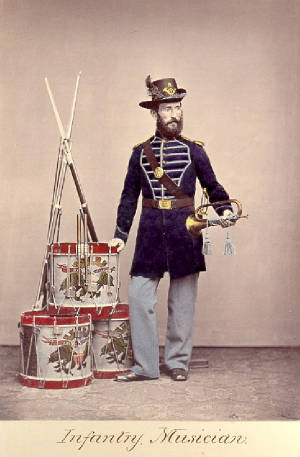|
If you were to join the 5th Minnesota, you would have been issued a uniform and gear (called acoutrements[akoo-tree-ments]).
But unlike modern soldiers who are made to look exactly alike in uniform, Civil War soldiers sometimes had slightly different
uniforms even in the same Regiments! You might see some soldiers with different hats, or slightly different colored coats
or pants (called trousers). We won't worry so much about the difference in this page, as much as WHAT the things a soldier
wore or carried are called and used for. Take a look at the two pictures below, and we'll start exploring what you might carry
if you joined the Union Army.

To the left is a PRIVATE. A Private is a simple soldier, the lowest rank in the Union Army. The Private wears the typical
"Union Blue" coat, called a SACK COAT. The Sack Coat is a simple coat that is very much like what a civilian would
wear. It would be made of wool, which could be very hot in the summer-but would also help keep rain and weather off of the
soldier too. His pants(called TROUSERS)are sky blue color, and have a patch on one knee. Civil War soldiers in both Armies
(Union and Confederate) would have to be very good with sewing, as their clothes didnt always last very long. A soldier would
only be given so many uniforms a year, so they had to last! To help with this, a soldier like this private would make or buy
a HOUSEWIFE-or a small sewing kit with needle, thread and patches of cloth. On this Private's feet are Union shoe's called
BROGANS. These would be made of leather, with wooden and leather soles (soles are the bottom of shoes). At one point, shoes
given (known as ISSUED)to Union soldiers might be made without a left and right shoe. In other words, the shoes would fit
EITHER FOOT! But as factories turned out more Brogans for the Union (also called the FEDERAL) Army, the practice of a left
and right shoe became standard. On this privates head is a hat called a BUMMER or FORAGE CAP. There were many kinds of hats
a soldier might wear, but this kind was common in the 5th Minnesota. (See below for some other hat styles soldiers sometimes
wore!) On the top of the hat are some pins made of brass. One looks like a trumpet (called a BUGLE), but there is also a letter
and number. These tell us what this soldiers job is, and what Company and Regiment he belongs to. The BUGLE is the symbol
for the infantry. He has a number 5 on his hat, which tells us he is in the 5th Regiment. Finally, the letter C tells us he
is in Company C (Regiments were numbered, and company's were lettered). This private has his MUSKET and BAYONET, but those
will be covered in "A Soldiers Weapons", so click that page for more on these. He is wearing a black leather belt
with a large bucle that says "US" on it. This belt is used to hold the Bayonet and Scabbard(A SCABBARD, or FROG,
is used to put a Bayonet into to carry it), and the CAP BOX. The cap box is a small leather pouch used to hold PERCUSSION
CAPS, needed to fire his MUSKET. See "A Soldier's Weapons" for more. Over his shoulder are two things. The white
strap attaches to his CANTEEN. This is made of a metal called TIN, and covered in WOOL. The CANTEEN is where this soldier
keeps water to drink. The other is a black leather strap that attaches to his CARTRIDGE BOX. A Cartridge Box is were this
soldier would keep the ammuntion (or Bullets)for his Musket. More on the Musket and ammunition in "A Soldier's Weapons".
Next, below and left, is a SERGEANT and CORPORAL. A Corporal is the next rank UP from a Private, and sometimes helps higher
ranks to get things done. The Sergeant is above the Corporal, and can often be in charge of groups of Privates and Corporals.

Above the Sergeant would be a LIEUTENANT; then a CAPTAIN, a MAJOR, and at the top of every regiment-a COLONEL.

If you had joined the Union Army, you probably would have started as a musician...
 Since the earliest times, young people have been soliders; but not all soldiers march unto the battlefield carrying weapons.
If you had joined the Army (Union or Confederate) during the Civil War, you probably would have begun as a musician. While
this may not seem an important job, in the days before radios and cell phones it was one of the most important jobs on the
battlefield! Musicians during the Civil War (and really for much of military history before improved communications came along)served
to make sure that the whole of the army knew what they were going to do and where they were going to go. Battlefields can
be very loud, and simply trying to shout orders wouldn't work. By using certain tunes (played very loudly) soldiers could
receive their commands and know what to do next. Musicians were also used to help set the pace for soldiers when on the march.
There are three main kinds of musicians: Buglers (Playing an instrument like a trumpet called a "bugle"), Fifers
(Playing a flute like instrument), and Drummers (who play a drum). Buglers did most of the work to send orders on the battlefield
(known as "Bugle Calls"), but drummers were sometimes used as well to tell soldiers when to fire their muskets.
Fifers, for the most part, were used to help tell soldiers how fast to march when they were on the move. When a large army
moved from place to place together, all three types of musicians would often play music for the soldiers to march to. If you
click the picture of the adult musician below, you can hear a marching song called "My Maryland March".
 This image of an adult infantry musician is courtesy of U.S. Army Quartermaster Museum. See more of the uniforms and items
used by U.S. Army soldiers at this site!
Click here!
|